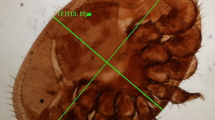Abstract
This is the first account of molecular and morphological characteristics of the stingless bee, Tetragonula iridipennis (Smith, 1854) from the Punjab (Northern India). The species was originally described from Sri Lanka. Using the standard barcoding protocols, cytochrome c oxidase subunit I marker (standard DNA barcode region) based DNA barcode sequence of the species has been established, as a first step towards DNA barcode library for stingless bees of Punjab. The barcode sequence generated for the species has been registered by GenBank, National Centre for Biotechnology Information under accession ‘KT960851’ and Barcode of Life Data Systems under Barcode Index Number ‘BOLD:ACT1038’. The host plant associations for T. iridipennis in Punjab are provided. Taxonomic comments on T. iridipennis and metric values of 40 morphological characters are also presented. The results can be used to further study the ecotypes in different parts of country, plant-pollinator interactions, habitat management and conservation programmes for stingless bees. Further, the precise identification of T. iridipennis and the inventory of its foraging plants would enhance its use as potential pollinator of crops, especially grown under protective cultivation wherein the Apis species are little useful and the hand pollination is highly laborious and costly.


Similar content being viewed by others
References
Moure JS (1961) A preliminary supra-specific classification of the old world meliponine bees (Hymenoptera, Apoidea). Stud Entomol 4:181–242
Rasmussen C (2013) Stingless bees (Hymenoptera: Apidae: Meliponini) of the Indian subcontinent: diversity, taxonomy and current status of knowledge. Zootaxa 3647(3):401–428
Smith F (1854) Catalogue of the hymenopterous insects in the collection of the British Museum. Part II, Apidae. British Museum (Natural History), London, pp 199–465
Ascher JS, Pickering J (2016) Discover life: apoidea species guide. http://www.discoverlife.org
Michener CD (2013) The meliponini. In: Vit P, Pedro SRM, Roubik DW (eds) Pot-honey: a legacy of stingless bees. Springer, New York, pp 3–17
Sakagami SF (1978) Tetragonula stingless bees of the continental Asia and Sri Lanka (Hymenoptera, Apidae). J Fac Sci Hokkaido Univ Ser VI Zool 21:165–247
Rasmussen C (2008) Catalog of the Indo-Malayan/Australasian stingless bees (Hymenoptera: Apidae: Meliponini). Zootaxa 1935:1–802
Rasmussen C, Cameron SA (2007) A molecular phylogeny of the Old World stingless bees (Hymenoptera: Apidae: Meliponini) and the non-monophyly of the large genus Trigona. Syst Entomol 32:26–39
Rasmussen C, Cameron SA (2010) Global stingless bee phylogeny supports ancient divergence, vicariance and long distance dispersal. Biol J Linn Soc 99:206–232
Rathore VS, Rasmussen C, Saini MS (2013) New record of the stingless bee Tetragonula gressiti from India (Hymenoptera: Apidae: Meliponini). J Melittol 7:1–5
Abrol DP (2012) Pollination biology: biodiversity conservation and agricultural production. Springer, Berlin, p 792
Couvillon MJ, Wenseleers VL, Fonseca VLI, Nogueira-Neto P, Ratnieks FLW (2007) Comparative study in stingless bees (Meliponini) demonstrates that nest entrance size predicts traffic and defensivity. J Evol Biol 21:194–201
Rahman A, Das PK, Rajkumari P, Saikia J, Sharmah D (2015) Stingless bees (Hymenoptera:Apidae: Meliponini): diversity and distribution in India. Int J Sci Res 4(1):77–81
Cubero OF, Crespo A, Fatehi J, Bridge PD (1999) DNA extraction and PCR amplification method suitable for fresh herbarium-stored, lichenized and other fungi. Plant Syst Evol 216:243–249
Michener CD (2007) The bees of the world, 2nd edn. Johns Hopkins University Press, Baltimore, p 992
Ruttner F (1988) Biogeography and taxonomy of honey bees. Springer, Berlin, p 284
Sakagami SF, Inoue T (1987) Stingless bees of the genus Trigona (subgenus Trigonella) with notes on the reduction of spatha in male genitalia of subgenus Tetragonula (Hymenoptera: Apidae). Kontyû 55:610–627
Hebert PDN, Cywinska A, Ball SL, deWaard JR (2003) Biological identifications through DNA barcodes. Proc R Soc Lond [Biol] 270:313–321
Chaudhary OP, Singh J (2007) Diversity, temporal abundance, foraging behaviour of floral visitors and effect of different modes of pollination on coriander (Coriandrum sativum L.). J Spices Aromat Crops 16:8
Gupta RK, Charan SK, Tiwari P (2011) Forage plant of Tetragonula iridipennis (Smith), a stingless bee (Hymenoptera, Apoidea, Apidae, Meliponini), in the desert of Thar in Rajasthan. J Environ Bio Sci 25:171–174
Pavithra N, Reddy Shankar M, Jayaprakash (2013) Nesting pattern preferences of stingless bee, Trigona iridipennis Smith (Hymenoptera: Apidae) in Jnanabharathi Campus, Karnataka, India. Int Res J Biol Sci 2(2):44–50
Mohan R, Devanesan S (1999) Dammer bees, Trigona iridipennis Smith. (Apidae: Meliponinae) in Kerala. Insect Environ 5(2):79
Premila K, Devanesan S, Arthur Jacob J, Shailaja K (2007) Foraging plants of stingless bee Trigona iridipennis Smith and physico-chemical characteristics of its honey. Abstr No 183. In: 40th Apimondia, International Apicultural Congress, Melbourne, Australia. Sept 9–14, p 129
Bomfim IGA, Bezerra ADM, Nunes AC, Aragao FAS, Freitas BM (2014) Adaptive and foraging behavior of two stingless bee species (Apidae: Meliponini) in greenhouse mini watermelon pollination. Sociobiology 61(4):502–509
Pessarakli M (2016) Handbook of cucurbits, 1st edn. CRC Press, Boca Raton, p 561
Acknowledgments
The authors extend sincere thanks to Dr. (Ms) Debjani Dey, Incharge, Insect Identification Service, National Pusa Collection, Division of Entomology, IARI, New Delhi and Dr. Rajiv K. Gupta, Professor and Former Head, Department of Zoology, Jai Narain Vyas University, Jodhpur for confirming the identity of the bee specimens.
Author information
Authors and Affiliations
Corresponding author
Ethics declarations
Conflict of interest
The authors declare that they have no conflict of interest.
Rights and permissions
About this article
Cite this article
Makkar, G.S., Chhuneja, P.K. & Singh, J. Stingless Bee, Tetragonula iridipennis Smith, 1854 (Hymenoptera: Apidae: Meliponini): Molecular and Morphological Characterization. Proc. Natl. Acad. Sci., India, Sect. B Biol. Sci. 88, 285–291 (2018). https://doi.org/10.1007/s40011-016-0757-4
Received:
Revised:
Accepted:
Published:
Issue Date:
DOI: https://doi.org/10.1007/s40011-016-0757-4




